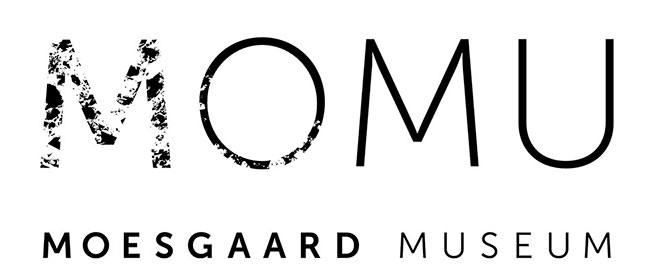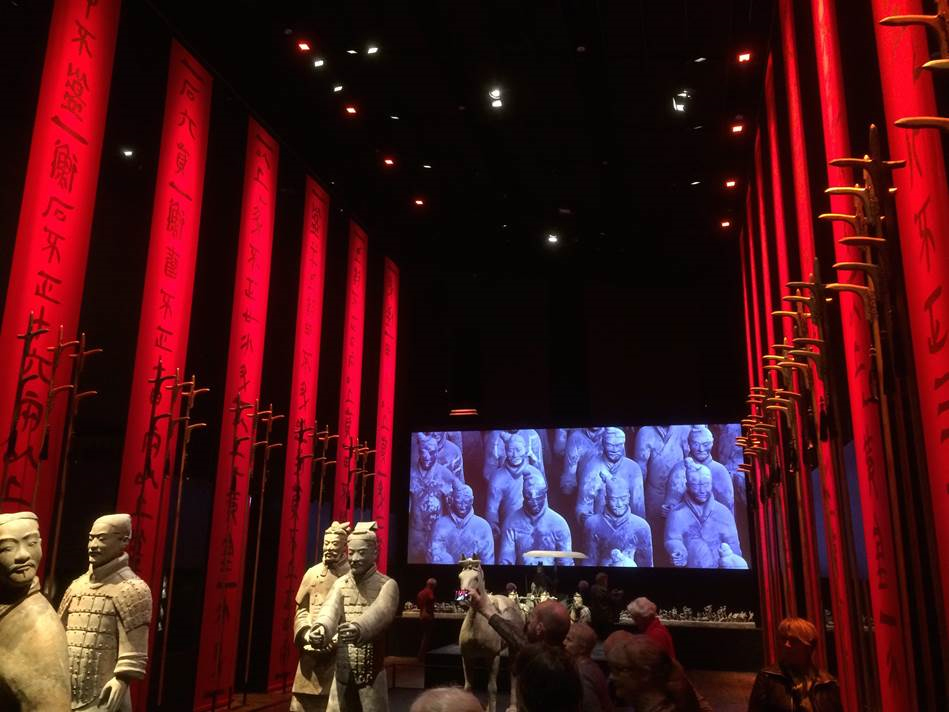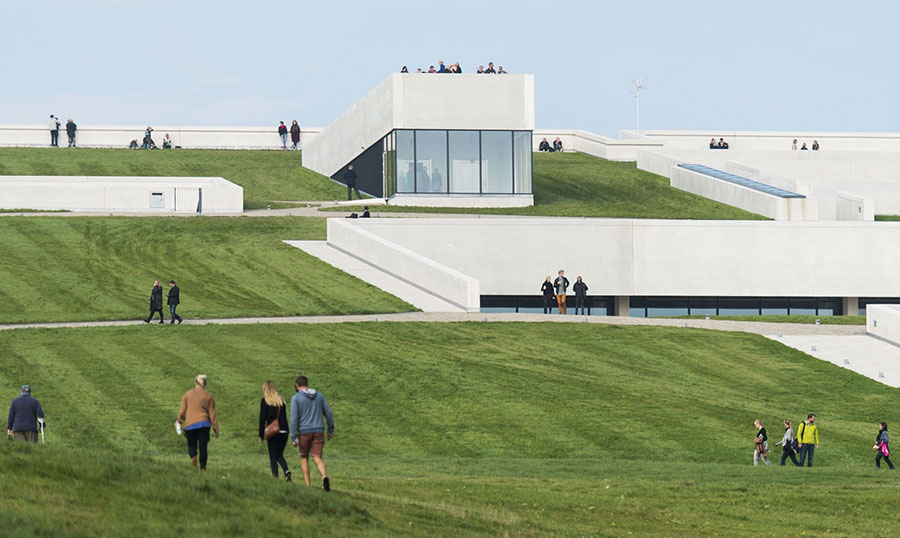
Case Study: Moesgaard Museum
Innovating the past
Download Case Study PDFMoesgaard Museum’s unique temporary exhibition celebrating China’s Terracotta Army has captured the attention of history fans and even received a visit from the Danish Royal couple. Zoe Mutter, of AV Magazine, examines how technology can enhance the presentation of historical treasures.
A novel approach to telling the stories of our ancestors has been adopted by Moesgaard Museum in Aarhus, Denmark. Stunning architecture, immersive technologies and culture are fused together to create an all-encompassing experience at the museum in Aarhus, Denmark, focusing on human history.
Unveiled in October last year, the 16,000 sq ft building was designed by Henning Larsen Architects to reflect an eco-friendly ethos and blend into the natural surroundings. The construction of a roof carpeted with grass that visitors could walk upon helped achieve this and transformed the museum into a local landmark.
Around 50,000 people experienced the blend of technology and historical exhibits in the first month of opening. But rather than visitors examining artefacts, the creative and technical geniuses behind Moesgaard wanted to create an impression of the world the people of the ancient ages inhabited. This is apparent upon entering the museum when visitors are greeted by lifelike waxwork reconstructions of the human species on the Evolution Stairway.
Moving further inside, the Museum is divided into archaeological and ethnographic content, an auditorium, conference rooms and a new 900 sq m area for special temporary exhibitions. Each of the permanent fixtures – Bronze Age, Iron Age and Viking Age – creatively deploys technology to complement exhibit content.
Moesgaard’s bold decision to take risks by exploring new ground has paid dividends with visitors continuing to react positively. A staggering 5,000 people passed through the museum’s doors over the Easter weekend for the unveiling of its first temporary exhibition which tells the story of China’s first emperor and his terracotta army.
This recent addition’s atmospheric soundscape and projection mapping interactive exhibit has created a real buzz and was inaugurated with a visit from the Danish Royal couple. Moesgaard’s technology offering will develop further in a year and a half when two additional permanent exhibitions open focusing on the Stone Age and Middle Ages.
A spectacular achievement
“It’s rare for a cultural and historical museum to be created from scratch as Moesgaard has. They are often obliged to make use of old listed buildings that dictate the scope for exhibitions,” explained Pauline Asingh, the Museum’s curator.
Moesgard Museum Exhibition Design Studio, guided by architect, Ole Birch Nielsen and exhibition technology manager, Johan Ahrenfeldt took an unconventional route to exhibit design and installation by challenging traditional exhibition concepts, believing some to be too elitist.
“Technology is integrated to add life to history and let people from the past come to the fore in our exhibits,” added Asingh.
Effective use of atmospheric soundscapes and lighting designs, animation, projection, interactive installation, scenography and narrative synergies between exhibitions in two levels draws visitors into the history and helps them identify with their ancestors.

“But what makes Moesgaard really special is the fact we managed almost everything in-house. I don’t know of another museum quite like this – normally museums deal with contractors,” explained Ahrenfeldt who headed up the entire audio visual and show control integration process.
“This was necessary to see the project come to fruition in the timeframe available as we worked as one efficient team striving to achieve the same goal. We started designing the exhibition in the spring of 2013 and one and half years later opened all the exhibits, so it was an insane process.”
Ahrenfeldt spent the first 15 months selecting equipment and designing systems before hiring two members of staff to support him with the mammoth project. Three months later, the AV team expanded further with six technicians when the technology began to be implemented and the creative vision developed.
Unconventional projection
Innovative mapping techniques are used to enhance multiple exhibits but few flat, white projection surfaces can be found, with most content projected on to unusual objects such as stones and soil. The Panasonic PT-RZ470 laser projector’s high contrast made it possible to display animation on to unconventional surfaces such as these.
This model also projected animation on to Denmark’s largest theatrical canvas which took pride of place in the Iron Age exhibition area’s mythical bog setting, creating a stunning backdrop to a collection of some of the world’s best preserved bodies.
If projection equipment is in use for many hours, cost is reduced when lamps do not require regular changing. “So as well as the power saving benefits the LED projectors offered they require little maintenance.”
A regular feature of museums and exhibitions, Panasonic’s DLP projectors boasted the brightness and interchangeable lens options demanded by Moesgaard. When coupled with the DLE-030 ultra-short throw lens the distance was then shortened by around 60 per cent compared to regular short throw lenses.
The Battle exhibit made use of five PT-DZ680 projectors with short throw lenses to display two animated Viking armies on opposite curved walls.
Other sections of the museum with restricted space and small projections make use of the smaller Vivitek Qumi Q7 projectors. The building has been constructed specifically to house exhibitions so multiple mounting options for all projectors are provided in the ceiling.
“Projection really works in museums – whereas displays are rectangular, you can fit projected content on to any shape or surface,” said Ahrenfeldt.
One of the Museum’s most striking examples of projection mapping is found in the recently opened Terracotta Army exhibit where visitors can colour a 3D warrior figure using a control pad. The replica warrior first needed to be scanned in 3D so programming and mapping could be completed.
The project – a collaboration with CAVI at the University of Aarhus – uses two Panasonic PT-RZ470 projectors to map the figure and another PT-DZ870 with a DLE030 lens to project content of multiple warriors on to the surface behind without any shadows being cast. An ELO 2244L touchscreen is used as a control pad. The installation is making use of two powerful PCs running UNITY software.

“Technology is integrated to add life to history and let people from the past come to the fore in our exhibits.”
– Pauline Asingh, MOMU curator
“I’m confident this type of interactive exhibit will become popular in museums, especially due to the evolving capabilities of 3D engines,” said Ahrenfeldt.
“It’s a very important part of the exhibition and we knew it would be popular with children. We spent a lot of time on interaction design, choosing computer hardware that could run the powerful 3D engines and working out which projectors could be placed discreetly whilst mapping in front of people with another projection just behind.”
Collaborating on content
With almost all elements of the project completed in-house, working in unison was imperative to its success. For example, when an architect presented an idea for an animation it had to be discussed with all departments to determine as a team how to proceed.
Animations and films were also mainly produced by the Museum’s in-house team but a selection of content was created by contractors – M2Film made the Bronze Age, Iron Age bog and sacrifice section, and Mark Film was responsible for the Illerup battle scene animation in the Iron Age section.
“We mainly rely upon animation because there isn’t footage from the eras we are examining,” said Ahrenfeldt. “Interactive animated content also plays a special part in attracting visitors of all ages. One highlight is an animated interactive game in the Mexico – Day of the Dead section which made use of Microsoft Kinect gesture recognition technology to pick up body movements. In other areas projected content is also triggered by infrared sensors connected to Kissboxes when visitors enter a specific area.”
The interactivity continues in the science lab where visitors can experiment with installations focusing on topics such as dental chronology and featuring Samsung and Panasonic screens along with Dell desktop monitors and Microsoft Surface tablets.
Seamless blending
The immersive experience visitors enjoy is made more seamless by displays subtly built into exhibit environments. Ahrenfeldt added: “By blending visuals, lighting and artefacts into one unit people don’t think about the separate components of an exhibit, they just enjoy the journey we take them on.”
In addition to supplying projectors Panasonic provided display panels of multiple sizes including three 42in TH-42LFE7ER and 17, 55in TH-55LF6W. Elsewhere 65in, 70in and 80in Panasonic screens were used for way-finding, video content and digital signage. Touch screen overlays – often paired with dynamic HD video content – then increased interactivity in a number of sections.
“We wanted to work with displays that could feature in multiple areas,” said Ahrenfeldt. “As well as the Panasonic models – which we picked because we’re using a lot of them and they offer high quality and affordability – I chose Samsung ME32C 32in screens because they are thin and boast good colour calibration and low power consumption. These were complemented by 30 of ELO’s 2244L 22in LCD touch monitors for interactive exhibits in which historians reveal additional details about artefacts.”
Standard mounting accessories were incorporated in many places with some screens such as the Panasonic 55in secured using Chief LSMVPU pull-out and Chief Thinstall mounts with specially constructed metal borders.
Creating mood with multi-channel sound
Multi-channel systems tailored to each exhibit are usually required for an ambient sound environment to enhance a museum experience, such as Moesgaard’s. For example, the battle scene demanded a special set-up comprising a 13-channel audio system mixed as two 5.1 settings.
“We had different goals for each zone. In the anthropological areas we tried to create an overall scene with sound – this consists of four 6.1 systems which never play at the same time,” said Ahrenfeldt. “It’s a soundscape that moves around the exhibition creating a variety of moods.”
In contrast more abstract but melodic audio was produced for the Bronze Age and Iron Age areas whilst the battle scene was enhanced by dramatic, cinematic sound and foley, making use of Merging Technologies Ovation media server and show sequencer and HAPI (networked audio) interface.
The Terracotta Army exhibit displays a unique selection of terracotta figures and objects reflecting the Emperor’s reign selected from 10 museums in China’s Shaanxi province. To do this special exhibit justice distinctive atmospheric audio was required.
“The audio in the new Teracotta Army section is extraordinary,” he added. “We’re using four System 6000 reverb units from TC-Electronic, relying on 24 channels to simulate the reverb in the ancient temple. We’re also using six DPA 4098 microphones to capture sounds created by visitors and then adding them into the soundscape. This cycles in loops of 15 minutes. It’s quite complex and an experiment we’re carrying out with TC-Electronics that will hopefully extend to other exhibitions.”

The Terracotta Warriors temple area’s audio set-up included Lab.gruppen Class D power amplifiers – Lucia, E Series and C Series with QLab multi-channel audio systems running, consisting of RME Fireface 802 and Ferrofish DA converters.
Other permanent exhibition sections feature Tannoy VX5.2, VX10BP, CMX401 and CMS503 speakers powered locally with low impedence Lucia amplifiers from Lab.gruppen. The JBL C65-PT and C67HC/T pendant speakers were the perfect choice to be hung discreetly from the ceiling in the Bronze Age, paired once again with Lucia, which Ahernfeldt believes to be one of the most powerful and flexible installation amp available.
Genelec active speakers – including the 4010, 4020 and 6010 models – were selected for their ease of mounting whilst the 5041 subs were fitted into walls, making the tech invisible to visitors. Atmospheric audio was once again incorporated into the Bronze Age area volcano and the battle scene, supported by TST429 transducers from Clark Synthesis.
All under control
From the project’s inception Ahrenfeldt designed a flexible infrastructure with the capacity to be expanded for future exhibitions and selected control and playback systems best suited to each exhibit. Having used Dataton’s Watchout system for several years, it was an obvious choice for Ahrenfeldt.
“This is my favourite media server for projection and specially configured PCs running Watchout and the WatchPax 2 were perfect for the Iron Age and battle exhibits. BrightSign players also feature heavily for video and audio content playback – we’re using 81 XD230 and 70 XD 1030 players.”
Almost everything is centralised, with the control hub relied upon by the Museum comprising a Medialon Manager Pro with seven Medialon Showmaster STs around the exhibition and six KissBox I/O devices for interactive installations.
Meanwhile Atlona equipment fulfilled signal distribution requirements. Atlona distribution partner, Imago Sonas, got involved on behalf of its dealer AV Center Vest. Moesgaard tested the first set of HDBaseT extenders before the Museum team and AV Center Vest took part in technical training hosted by Imago Sonas in Aarhus.
Equipment included Atlona’s AT-HDTX-RSNET (This product has been replaced by the AT-UHD-EX-100CE-TX.) HDMI 100m extenders feeding Panasonic Digital Link projectors and the AT-HDRX (This product has been replaced by the AT-UHD-EX-70-KIT.) HDMI extender for other projectors and displays. The connection offered, ensuring HDMI signals are sent direct to the projector over long distances, was a key factor in the decision to use Atlona technology along with the compatibility it offers with Panasonic’s Digital Link system. Both signal and projector control are featured through one Cat cable.
“The museum required signal splitting and stability whilst using HDBaseT technology. It was important Atlona’s local support was available direct from the distributor,” said Mads Nørskov, sales director, Imago Sonas.
Imago Sonos wanted to keep the number of boxes to a minimum and since the Panasonic projector has an HDBaseT input (Digital-Link) they could cut away the receiver on all the extender sets that were used with Panasonic projectors.
An illuminating atmosphere
The overall lighting design and selection of fixtures was handed over to external lighting designers and together with Ahrentfeldt they decided on MA Lighting’s MAonPC command wing system for overall lighting control.
Two designers created the exhibits’ atmospheric looks – each one producing a different mood through illumination. This was in part due to their contrasting backgrounds – Henrik Vierø works in film, television, photography and exhibition lighting design and Nikolaj Birkelund specialises in museum and architectural lighting.
Vierø and Birkelund complemented the exhibits’ dramatic storytelling with their designs; many of the displays and structures requiring individual solutions to create the desired look and feel. In the displays all artefacts are lit with dedicated lightsources and in that way the artefacts become the illuminating element. This concept also saved energy and avoided glare from stray light.
“We also had to look at each room, area and even display as a separate location as if it was a scene in a film or at the theatre,” said Vierø.
Special dimming curves were developed for some installations so everything was in synch with projection and animation. Both designers then attempted to adjust the rooms’ so in the large bog exhibition space, a hand-painted, theatre-style landscape backdrop was cleverly illuminated to create a 15-minute night-to-day change in the room.
“The effect is subtle but helps underline the overall mood in the area. A changing environment like the backdrop can evoke feelings in visitors even though they are not consciously aware,” said Birkelund.
In the Battle cinema visitors find themselves in the middle of an Iron Age combat with transducers in the floor creating an enveloping audio experience. But as crucial as the sonic and projection elements are, they don’t overshadow the lighting. After the battle scene the artefacts that featured in the animation come to view through being illuminated by fixtures built into the displays.
The Ethnographic exhibition – a black room with dark walls, floor and ceiling examining the ways people remember their deceased relatives – features a display case containing ceremonial tribal masks, each one representing a stage of manhood. Here the story is told through subtle lighting which highlights one mask and leaves the rest in darkness.
Over 20 fixture types – predominantly LED models – were chosen, many of which were modified to meet the Museum’s specifications. The fixture list included the K7 and Force V from Brother, Brother & Sons, Philips Selecon PL1 LED luminaire, Hurricane 35 from ACDC Lighting, BoxLED from Osram, Megaman Toby for track lighting, LED flexstrips from OptoLED and OSRAM and Darklight Precision RGB fixtures.
The designers worked closely with the curators to ensure correct light levels were maintained as no harsh light can be shone upon certain artefacts – some of which are as much as 3,000 years old, to ensure they are not degraded. Many items such as the best preserved bog body, the Grauballe Man, do not tolerate high levels of light or UV rays.
Many locations are dimly lit but thanks to high quality LED fixtures lights could be incorporated inside display cases for more dramatic effects due to the low heat emitted.
Key for Birkelund and Vierø was enhancing the story being told by creating the feeling of entering the pit and excavating excavating artefacts. “So this concept went well with the acceptable amount of light some artefacts could stand,” said Vierø.
“We could work fast because the Museum had established its own in-house design team so access to drawing material and designers was immediate.”
It was this seamless process between the designers and the entire team that has resulted in a museum concept that has hit the mark, attracting 200,000 visitors since opening its doors. Architects, IT designers, film creators, animators, scenographers, photographers, archaeologists and social anthropologists have collaborated on a creative development process to produce a visitor attraction that captivates multiple generations.
Please note: This case study features products have been replaced with updated Technology. Please see “Products Featured” box below for a listing of the latest products.
| PRODUCTS FEATURED | PRODUCTS FEATURED |
| AT-UHD-EX-100CE-TX | HDBaseT transmitter for HDMI transmission up to 330 feet (100 meters) over category cable with Ethernet pass through, plus RS-232 and IR control |
| AT-UHD-EX-70-KIT | 4K/UHD HDMI over HDBaseT transmitter/receiver kit for HDMI transmission up to 230 feet (70 meters) over category cable with Power over Ethernet capability |







